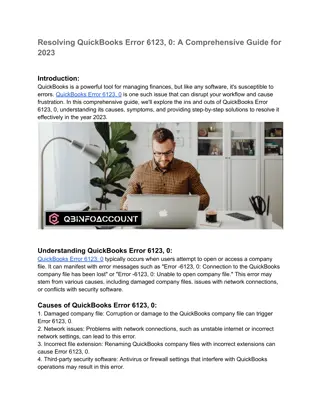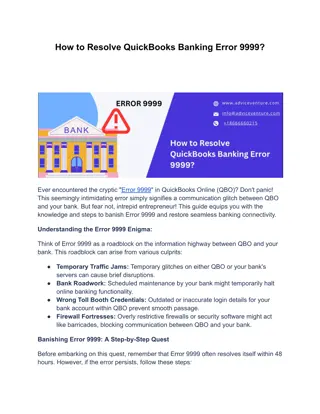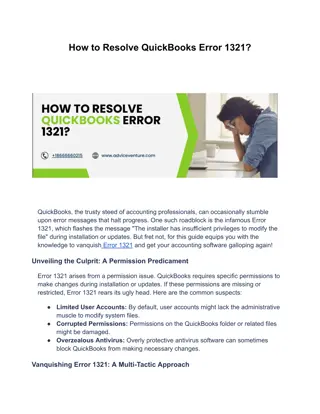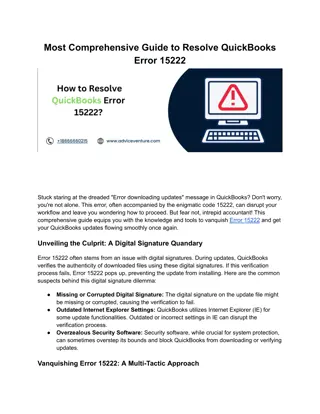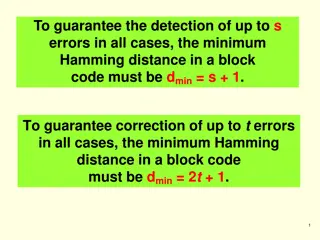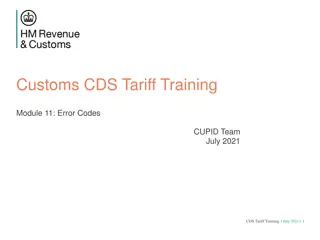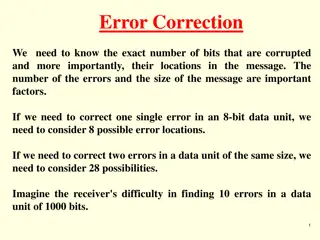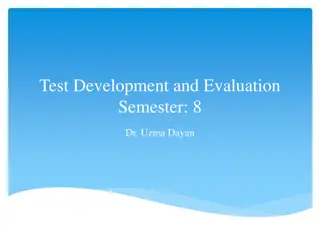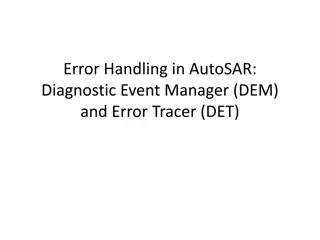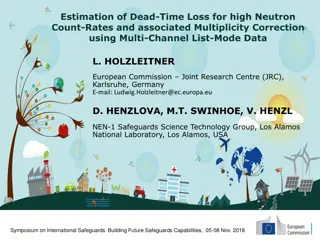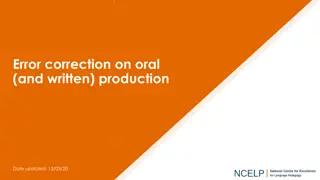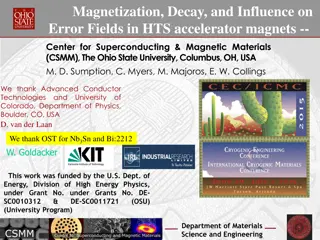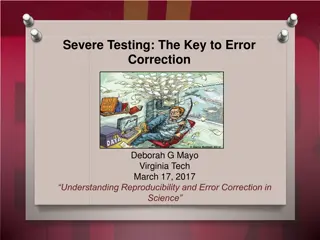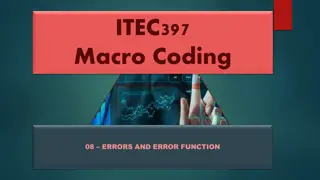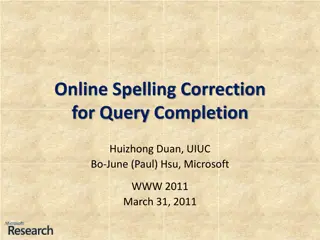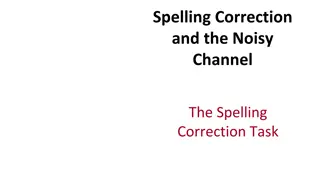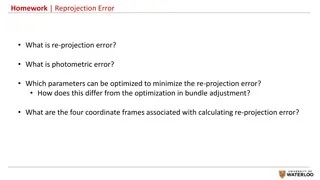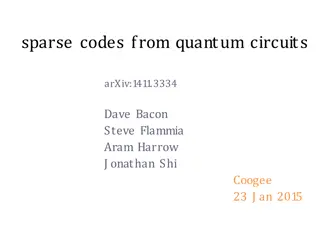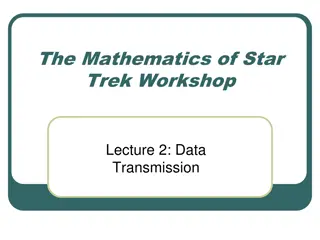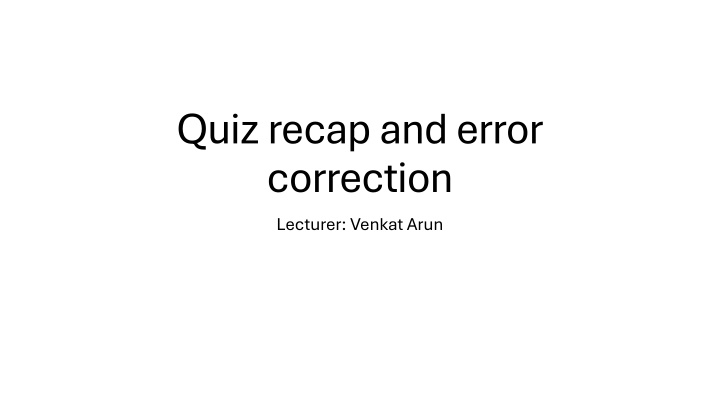
Digital Errors and Error Correction Models
Explore the concepts of digital errors and error correction through simple models, probability density functions, and examples like triple repetition codes. Learn how errors can impact data transmission and how encoding techniques can help in error detection and correction in the digital world.
Download Presentation

Please find below an Image/Link to download the presentation.
The content on the website is provided AS IS for your information and personal use only. It may not be sold, licensed, or shared on other websites without obtaining consent from the author. If you encounter any issues during the download, it is possible that the publisher has removed the file from their server.
You are allowed to download the files provided on this website for personal or commercial use, subject to the condition that they are used lawfully. All files are the property of their respective owners.
The content on the website is provided AS IS for your information and personal use only. It may not be sold, licensed, or shared on other websites without obtaining consent from the author.
E N D
Presentation Transcript
Quiz recap and error correction Lecturer: Venkat Arun
Simple model for why errors happen What sender sent PDF 0V becomes approx. [-0.25, 0.25] V What receiver got (probability density function) PDF
Simple model for why errors happen Encodes 00 01 10 11 What sender sent PDF What receiver got (probability density function) PDF Enough overlap that bits get confused
What errors look like in the digital world Bit that is received Bit that is sent 1 1 1 - p p p 0 0 1 - p The values on the edges denote the probability that the transmitted bit is received as a 0 or a 1
What errors look like in the digital world Bit that is received Bit that is sent 1 1 1 - p p Key takeaway: probability of error is p If p < 0.5, when a sequence of bits is sent, 1-bit errors are more likely than 2-bit errors which are more likely than 3-bit errors p 0 0 1 - p The values on the edges denote the probability that the transmitted bit is received as a 0 or a 1
Example of an error correcting code: triple repetition Data I want to transmit Data I want to transmit 0 1 How I encode the data How I encode the data 000 111 What I receive What I receive 000 111 What I interpret it as What I interpret it as 0 1
Example of an error correcting code: triple repetition Data I want to transmit Data I want to transmit 0 1 How I encode the data How I encode the data 000 111 What I receive What I receive 000 111 001 What I interpret it as What I interpret it as 0 1 ??
Example of an error correcting code: triple repetition Data I want to transmit Data I want to transmit 0 1 How I encode the data How I encode the data 000 111 What I receive What I receive 000 111 001 011 What I interpret it as What I interpret it as 0 1 0 ??
Example of an error correcting code: triple repetition Data I want to transmit Data I want to transmit 0 1 How I encode the data How I encode the data 000 111 What I receive What I receive 000 111 001 011 101 100 What I interpret it as What I interpret it as 0 1 0 1 1 0
A longer error correcting code Data I want to transmitHow I encode the data Points to note Points to note Every bit-string on the right differs from every other bit-string by at least 3 bits. This is called as having a hamming distance of at least 3 This means that if one bit of any codeword is flipped, its distance to every other codeword is >= 2. Its distance to the original codeword is of course 1. Thus, it can be decoded If two bits are flipped, it cannot be corrected but the error can be detected detected since no two codewords differ by 2 bits (codeword) 0 0 0 0 0 0 0 1 1 0 1 0 0 1 0 1 0 1 0 1 0 1 0 0 0 0 1 1 1 0 0 1 1 0 0 0 0 1 1 0 0 1 1 1 0 0 1 1 0 0 0 0 1 1 1 1 1 1 1 0 0 0 0 0 1 0 0 1 0 1 1 0 1 1 0 1 0 0 1 1 0 0 1 1 0 1 1 1 1 0 0 1 0 1 0 1 0 1 0 0 1 0 1 1 0 1 1 1 1 1 1 1 0 0 0 0 0 0 0 1 0 0 1 0 0 0 1 1 0 1 0 0 0 1 0 1 0 1 1 0 0 1 1 1 1 0 0 0 1 0 0 1 1 0 1 0 1 0 1 1 1 1 0 0 1 1 0 1 1 1 1 0 1 1 1 1 corrected, How do we come up with this table? This is called a hamming code and is out of scope of this course. It is simple enough to understand though
A longer error correcting code Data I want to transmitHow I encode the data Here, we are encoding 4 bits as 7 bits (codeword) 0 0 0 0 0 0 0 1 1 0 1 0 0 1 0 1 0 1 0 1 0 1 0 0 0 0 1 1 1 0 0 1 1 0 0 0 0 1 1 0 0 1 1 1 0 0 1 1 0 0 0 0 1 1 1 1 1 1 1 0 0 0 0 0 1 0 0 1 0 1 1 0 1 1 0 1 0 0 1 1 0 0 1 1 0 1 1 1 1 0 0 1 0 1 0 1 0 1 0 0 1 0 1 1 0 1 1 1 1 1 1 1 0 0 0 0 0 0 0 1 0 0 1 0 0 0 1 1 0 1 0 0 0 1 0 1 0 1 1 0 0 1 1 1 1 0 0 0 1 0 0 1 1 0 1 0 1 0 1 1 1 1 0 0 1 1 0 1 1 1 1 0 1 1 1 1 In general, for all m, you can encode 2? ? 1 bits using a codeword of 2? 1 bits. In each case, you can correct 1 bit errors and detect 2 bit errors For example: 1 bit 3 bits (efficiency: 0.333, m = 2) 4 bits 7 bits (efficiency: 0.571, m = 3) 11 bits 15 bits (efficiency: 0.733, m = 4) 16 bits 31 bits (efficiency: 0.839, m = 5) Key takeaway: Key takeaway: To correct/detect a given number of bit errors, the longer codewords you use, the greater the efficiency. Efficiency approaches 1 as codeword length goes to infinity!
Multi-bit correction: How much error correction do we need? Bit that is sent Bit that is received 1 - p 1 1 p p 0 0 1 - p If probability of error is ?, then we will have ?? errors in every K bits Magic of statistics: as K , the number of errors will be almost exactly K? In case you are interested, this is called the law of large numbers
Multi-bit correction: How much error correction do we need? If probability of error is ?, then we will have ?? errors in every K bits Magic of statistics: as K , the number of errors will be almost exactly K? In case you are interested, this is called the law of large numbers Task: To transmit N bits, we need to find a K > ? bit code book (set of codewords) that encodes K bits such that we can correct Kp. Efficiency is N / K Shannon s theorem (informally stated): Shannon s theorem (informally stated): For every channel with probability of error p, we can construct bigger and bigger code books (i.e. larger and larger N and K) such that the efficiency approaches 1 H(K). That is, ? ? Here, ? ? = ?log? 1 ? log1 ? ? 1 ?(?) as
Multi-bit correction: How much error correction do we need? If probability of error is ?, then we will have ?? errors in every K bits Magic of statistics: as K , the number of errors will be almost exactly K? In case you are interested, this is called the law of large numbers Task: To transmit N bits, we need to find a K > ? bit code book (set of codewords) that encodes K bits such that we can correct Kp. Efficiency is N / K Shannon s theorem (informally stated): Shannon s theorem (informally stated): For every channel with probability of error p, we can construct bigger and bigger code books (i.e. larger and larger N and K) such that the efficiency approaches 1 H(K). That is, ? ? Here, ? ? = ?log? 1 ? log(1 ?) is called information entropy ? 1 ?(?) as
Multi-bit correction: How much error correction do we need? Task: To transmit N bits, we need to find a K > ? bit code book (set of codewords) that encodes K bits such that we can correct Kp. Efficiency is N / K Shannon s theorem (informally stated): Shannon s theorem (informally stated): For every channel with probability of error p, we can construct bigger and bigger code books (i.e. larger and larger N and K) such that the efficiency approaches 1 H(K). That is, ? ? Here, ? ? = ?log? 1 ? log(1 ?) is called information entropy ? 1 ?(?) as Strategy: Strategy: Pick a very large ? and pick ? = 1 ? ? ?
Key takeaways The following is all I expect you to understand about multi-bit error coding: We can encode messages by their corresponding codewords A bit-flip channel flips the bit with probability p For p, there is a maximum achievable efficiency for messages sent through that channel. That is, we can encode N-bit messages using K-bit codewords such that N / K approaches this maximum as ?
Fun aside: How do we correct more bit errors? Shannon s code: For every N-bit message, pick a random K-bit string as the codeword. Let this mapping from message to codeword be C(m). The sender and receiver need to agree on this function Decoding strategy: given a received value of x, find a message m such that the hamming distance between x and C(m) is minimized. m will be the most likely transmitted message What is the computational complexity of this decoding process?
Fun aside: How do we correct more bit errors? What is the computational complexity of this decoding process? Possible strategy to decode received message x: I received x Is? 1? a message? If so, return ? 1(?) For all integers i For all x such that hamming distance between x and x is i Is ? 1(?) a message? If so, return ? 1(?) Complexity: there are 2?such x !
Key takeaways and some history Decoding Shannon codes has exponential complexity Shannon published his ground-breaking work, including the Shannon code, in 1948 However, for a long time we did not have a coding scheme that approached the theoretical limit and could be decoded in efficiently (note the two different types of efficiency here). In the 1990s, we started studying the first solutions to this problem (called Turbo codes and LDPC codes) This revolutionized cellular and WiFi networks because, for the first time, they were able to approach the theoretical optimal message transmission rates! This was quickly adopted everywhere Side note: Turbo codes were patent protected until a few years ago. This made LDPC codes more popular in some places
Key takeaways and some history Thanks to these new coding schemes, we could start packing bits more tightly. This way, errors were more likely to happen, but we had efficient methods to correct them. This is what allowed wireless networks to achieve greater efficiency Tighter, more aggressive encoding More conservative encoding that prevented errors

